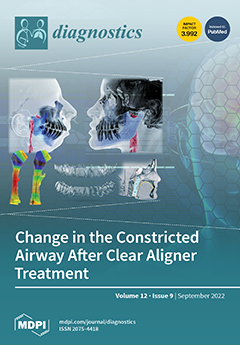Malaria is one of the most common tropical diseases encountered by members of the French military who are deployed in operations under constrained conditions in malaria-endemic areas. Blood smear microscopy—the gold standard for malaria diagnosis—is often not available in such settings, where the
[...] Read more.
Malaria is one of the most common tropical diseases encountered by members of the French military who are deployed in operations under constrained conditions in malaria-endemic areas. Blood smear microscopy—the gold standard for malaria diagnosis—is often not available in such settings, where the detection of malaria relies on rapid diagnostic tests (RDTs). Ten RDTs (from Biosynex, Carestart, Humasis, SD Bioline, and CTK Biotech), based on the detection of the
Plasmodium falciparum histidine-rich protein 2 (HRP2) or lactate dehydrogenase (pLDH, PfLDH, or PvLDH), were assessed against 159 samples collected from imported malaria cases, including 79
P. falciparum, 37
P. vivax, 22
P. ovale, and 21
P. malariae parasites. Samples had been previously characterised using microscopy and real-time PCR. The overall sensitivities for the
Plasmodium test ranged from 69.8% (111/159) to 95% (151/159). There was no significant difference for the specific detection of
P. falciparum (96.2% to 98.7%,
p = 0.845). No significant difference was found between sensitivities to
P. vivax by pan LDH or pvLDH (81.1% (30/37) to 94.6% (35/37) (
p = 0.845)). Some of the RDTs missed most of
P. ovale and
P. malariae, with sensitivities for all RDTs ranging respectively from 4.5% (1/22) to 81.8% (18/22) and 14.3% (3/21) to 95.2% (20/21). Carestart Malaria Pf/Pan (pLDH) Ag G0121, a pLDH-based RDT (PfLDH and pLDH), showed the highest sensitivities to
P. falciparum (98.7%, 78/79),
P. vivax (94.6%, 35/37),
P. ovale (81.8%, 18/22), and
P. malariae (95.2%, 20/21) and meets the requirements for military deployments in malaria-endemic areas.
Full article






